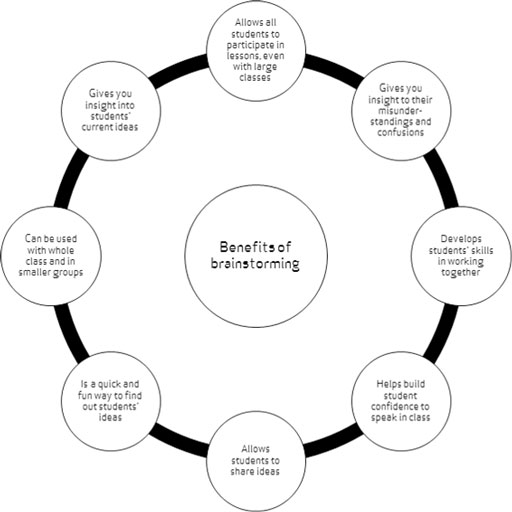2 Brainstorming in the classroom
Stimulating your students’ imagination and encouraging them to think about what they know means that you need to be creative in the ways you work. The exercise you tried in Activity 1 is just one way of brainstorming; as you will have experienced, it stimulates the brain and encourages you to think more widely. Now try this approach with your class before exploring other ways to use brainstorming.
Activity 2: Brainstorming sound with your class
Students need to be introduced to the technique of brainstorming. Before you do the brainstorm, think about how you will introduce the technique. What are the key things they need to know about what they have to do?
It is important that during brainstorming:
- students respect whatever is said
- that everyone has the right to speak
- taking turns is accepted
- the more varied the answers, the better.
You need to be clear about why you are brainstorming with your class. What do you want to find out from your students about what they know about sound or another topic?
Once you have written your plan, you are ready to try out brainstorming with your students. Try the brainstorming strategy with your class. If you can, get your colleague to do it as well with one of their classes.
After you have both tried brainstorming, spend some time thinking about how well the session went and why you think this.
Pause for thought After the brainstorming session, think about the following:
|
All of your students will have some knowledge about most topics that you teach, including sound. But not all students will have the same ideas and the ideas they do have are unlikely to be fully developed.
As you plan a teaching session, be it a practical or more theoretical lesson, it is important to know what your students already understand so that you can target your teaching more directly. You need to extend their learning, not waste time teaching what they already know and understand. So brainstorming is a good way of helping learners to think about a topic and share their ideas.
A brainstorm on sound might show where students have confused or underdeveloped ideas about how sounds are made. With this knowledge you will be able to target your teaching more directly to their learning needs and challenge their thinking further. To do this you might, for example, plan some short activities that help them to think about what is happening when sounds are made and why the sound is produced as it is.
Some students who have special educational needs will require more support and may benefit from activities being broken down into more manageable parts.
Not only does brainstorming help you understand what your learners already know, but it can also build your students’ confidence by encouraging them to participate more actively in the lesson. Some of the key benefits are summarised in Figure 2.
Resource 1, ‘Talk for learning’, provides insight into the benefits of talk for students in aiding their learning. You might find it useful to read this now before you continue working with your students – it will help you explore ways to encourage students to talk about their ideas and understanding.
1 What is brainstorming?

